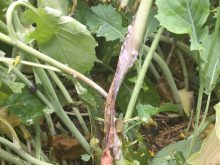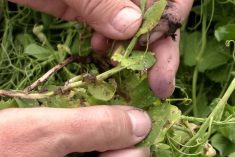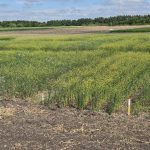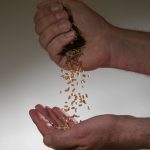In Prince Edward Island, potato growers may soon lose the use of metalaxyl, a key fungicide registered for use against Phytophthora erythroseptica, the pathogen responsible for pink rot.
According to the results of a national survey, 50 per cent of isolates studied in Ontario and Eastern Canada are resistant to Ridomil, a single-site mode of action chemistry used to control pink rot, late blight and pythium leak in potatoes.
Although resistance to metalaxyl is not yet predominant in Western Canada, growers should exercise caution and mix up modes of action where possible, says Rick Peters, a research scientist with Agriculture and Agri-Food Canada based in Charlottetown, P.E.I.
Read Also

‘Sustainable’ versus ‘regenerative’ agriculture
It seems there is confusion between the terms “sustainable” and “regenerative” as applied to agriculture. Both are even perceived, in some instances, as forms of organic farming.
Peters was at Manitoba Potato Production Days in Brandon, Man. this January to speak on fungicide resistance in pink rot populations in Canada.
Peters said researchers first noticed resistance popping up in 2004 in New Brunswick. When pink rot hit P.E.I. growers hard in 2012, a national survey was initiated for 2013-14.
- Read more: Watch for wireworm in potatoes
The study showed an overall, national resistance of 39 per cent, with most resistance showing up in Eastern Canada. “Resistance is skewed to Eastern Canada, and it’s just showing up in Western Canada now,” said Peters.
The study, a collaborative effort between AAFC, Syngenta, Keystone Potato Producers Association, Potato Growers of Alberta and the P.E.I. Potato Board, has just been renewed for a two-year term running from 2015 to 2016.
It also involves a project examining alternative management options for pink rot, based at AAFC’s Harrington Research Station near Charlottetown. Results will be published in 2017.
Phosphite products
P. erythroseptica is soil- and seed-borne, not air-borne. According to Peters, the fungus develops resistance via overuse of Ridomil’s single-site mode of action.
“Ridomil was the go-to product for many years, so like in late blight, once resistance started to appear resistance began to dominate,” he said.
But an alternative mode of action is already on the horizon. Peters’ team is studying the efficacy of three phosphite products as foliar or post-harvest treatments. These products are registered in Canada under trade names Confine Extra, Phostrol and Rampart.
In trials at Harrington, both products were highly effective at managing strains of the pink rot pathogen, said Peters, especially when used as a foliar treatment. He recommends at least three applications through the season of around two to two and a half litres per acre, or seven to 10 litres per acre total to achieve good disease control.
Phosphites offer good control because they are highly systemic and translocate down to the tubers, he said. An added bonus is the strong environmental profile of phosphites relative to other chemistries.
But growers should avoid applying phosphites as a seed treatment in-furrow, said Peters.
“We like the foliar approach because it’s protecting right in the field and carries over to harvest. And there are situations when post-harvest treatment can be helpful, such as when there’s a lot of risk at harvest, like bruising or wetness.
“When it’s wet, pink rot produces a swimming spore that can swim to the roots and tubers. This product is effective at protecting those areas. This is the only systemic product like this,” Peters added.
Applied post-harvest, phosphites also offer protection against silver scurf.
But Peters maintains that growers should be as proactive, and creative, as possible when it comes to managing or forestalling metalaxyl resistance.
“It’s a good idea to follow resistance management strategies — mixing or alternating products, using a broad-spectrum approach or non-chemical methods,” he said.
Growers should manage irrigation water and take care to avoid bruising and wounding tubers at harvest.
Samples of infected tubers should be sent to the provincial survey coordinator for forwarding to Peters’ lab at AAFC, 440 University Ave., Charlottetown, Prince Edward Island, C1A 4N6. Contact Dr. Rick Peters at [email protected] or phone 902-370-1370 for more information.















